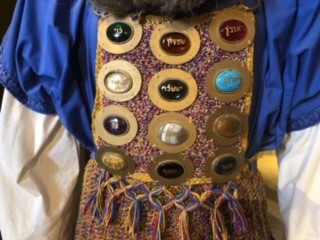
by Phyllis Chesler
Oy, how many detailed, but specific commandments do we have in this parsha! What does it have to teach us today?
Come and hear how Nehama Leibowitz interprets these instructions which are primarily meant for Aharon, the Kohen Ha Gadol. Remember, we are talking about the High Priest’s removal of ashes (!) and how he must dress while doing so. When he removes the ashes “he should dress in his linen garment (6:3); but when he takes the ashes outside the encampment, he must dress in other garments (6:4). What can this possibly mean?
Leibowitz cites various opinions. The priest must “enhance the sanctuary and beautify it to the utmost of (his) ability” (Sefer HaHinukh). “The servant should not wait upon his master in his kitchen clothes, therefore: “(he must) put on other garments.” (Rashi). But even the second set of clothes are priestly garments—the Torah “need not state ‘other garments’ if ordinary clothes were meant.” (Ha’amek Davar).
And what does any of this have to do with us? (Echoes of our second Pesach question).
According to Leibowitz, quoting Rabbenu Bahya ben Asher: “all ritual or religious assignments should be carried out in a worthy and decorous manner.” And in terms of changing into inferior, priestly clothing, she quotes Rabbenu Bahya Ibn Pakuda: “(This is done) in order to humble himself and remove the haughtiness from his heart…Significantly, it is in the Inner Sanctuary that the High Priest faces his Master in the most sumptuous attire. However, when exposed to the throngs, he dresses more simply and performs a menial task so as to erase all pride from his heart.”
Leibowitz goes further and quotes Rabbi S.R. Hirsch who tells us that “the residue of the previous day (must be carried away) in worn-out and old clothes. One must not regale oneself in pomp for that which belongs to the past; it is superseded by the present mitzva that each day bids us to observe.”
If we are now all in the shadow of—and the heirs to—the Once and Future High Priest, we are being told to dress somewhat magnificently when we pray, or at least better than we do in our daily lives. I am not sure if we are also meant to move on, to not look back, to know that we exist in the one and only present moment, and are meant to observe the mitzvot anew, as if for the first time.
What do you think? According to the Ramban, citing Rashi and Onkelos, there were anywhere from four to eight garments that constituted the priestly “garment.” Who laundered all this costly linen? And who fashioned it?
Shabbat Tzav Shalom.
- Like
- Digg
- Del
- Tumblr
- VKontakte
- Buffer
- Love This
- Odnoklassniki
- Meneame
- Blogger
- Amazon
- Yahoo Mail
- Gmail
- AOL
- Newsvine
- HackerNews
- Evernote
- MySpace
- Mail.ru
- Viadeo
- Line
- Comments
- Yummly
- SMS
- Viber
- Telegram
- Subscribe
- Skype
- Facebook Messenger
- Kakao
- LiveJournal
- Yammer
- Edgar
- Fintel
- Mix
- Instapaper
- Copy Link










One Response
I am in awe of your Parsha commentaries. Thank you
Do you have a mailing list? If so, please put me on it.